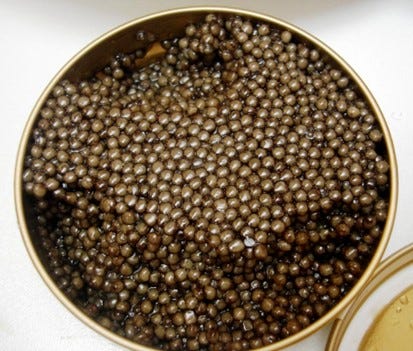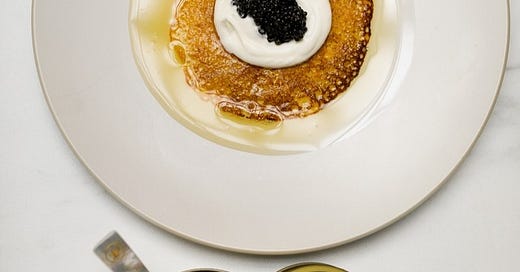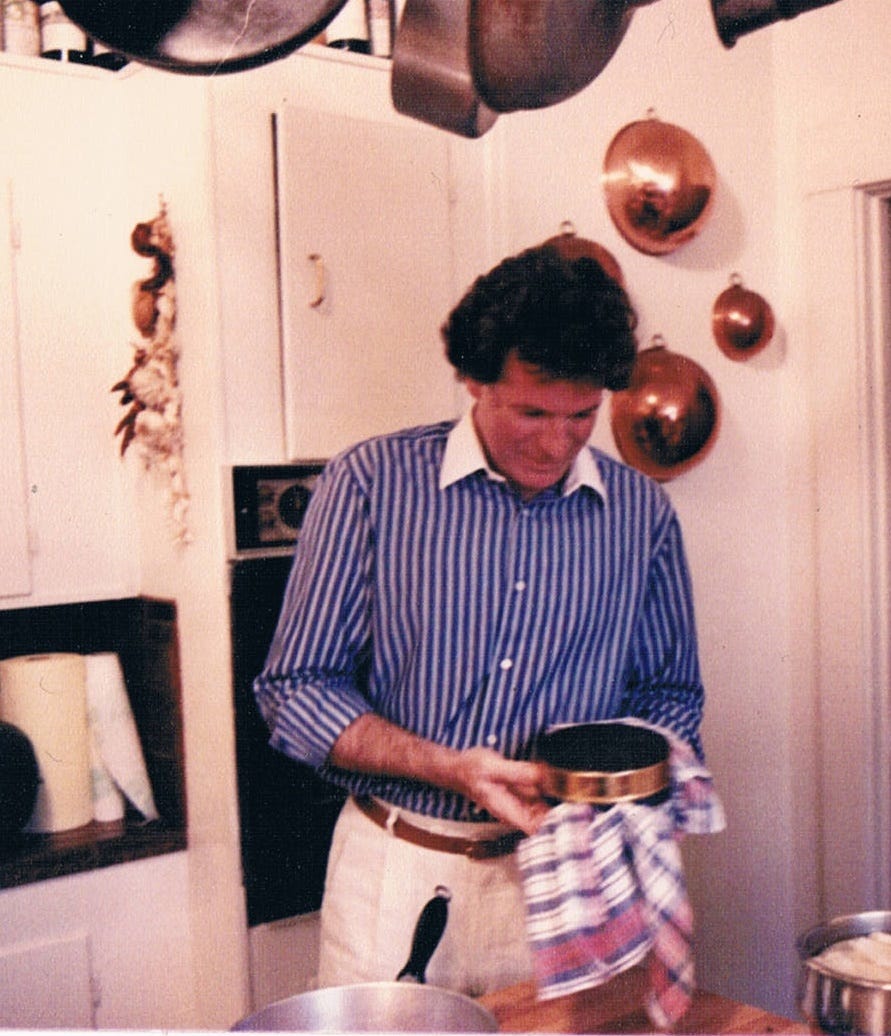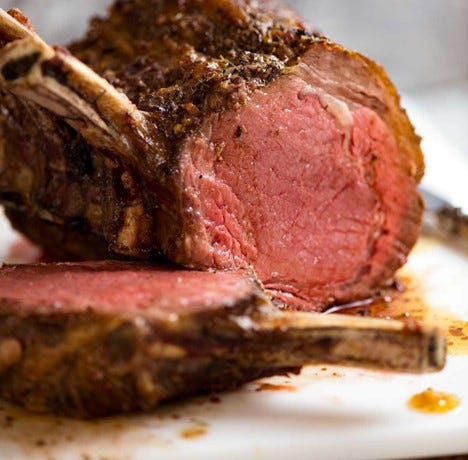Ask me what happened last week, and I couldn’t tell you, although it’s easier if you ask me about great food and wine. I can tell you about fresh abalone in Big Sur, late lunches at Zuni beginning with the most perfect margaritas or eating soft-boiled eggs with black-truffle butter sauce with Ken Hom and Daniel in their Dordogne (France) kitchen. But even then I need the right moment and probably a glass of champagne to get started. Preferably over lunch.
I find eroticism helps.
It’s a fixative for food memory, and my earliest (at ten) one was at the legendary Mirabelle in London, watching the Aly Khan, son of the hefty Aga then recently weighed in diamonds by his followers (he kept the diamonds), polish off enough food for ten while his beautiful companion finished off a kilo of Beluga caviar from it’s can.


It wasn’t the quantity or expense of food that entranced me. What riveted me were the arm-length black-velvet gloves still on the woman while she piled the little toasts high with pale-grey eggs. And her licking off half the caviar with a pink tongue before sliding the rest delicately into her carmine-lipped mouth. All that and the sight of the thick diamond bracelets covering her wrists and the sapphire-eyed diamond snakes curling up her arms convinced me for the first time that I could not wait to ‘grow up’ and find someone who wore those gloves.
When I finally grew older, if not grown up, and could afford caviar, I introduced my friends to blini instead of toasts.
I told them how my teen-age companion the ancient Count Sheremetev (childhood friend of Felix Yusupov who shot Rasputin) told me that when eating blini if the melted butter does not run down the inside of your sleeve and reach your elbow, use more butter.
Blinis are the supremely best way to kick-start an eating party. The success is instantaneous.
Pour four tablespoons of hot, melted clarified butter over each buckwheat flour or cornmeal little pancakes or blini. Put a tablespoon of smooth and cool sour cream in the center. Spoon on caviar or, if on a budget, delicious diced smoked salmon, smoked trout, or herring.
The day before you have put some vodka in the freezer with shot glasses. The procedure is important: all stand around together, shoot the silkily cold buffalo grass Zubrovka down in a gulp, wait five seconds for an indication of burn in your throat, then roll up the blini and pop the whole thing into your mouth.
The resulting swoon is because the body can only barely take that much sensation without blacking out.
Their only equivalent is an apricot-sized perfectly white, crumbly meringue with a slightly tacky interior, filled to bursting with fresh Devon clotted cream. That I used to treat myself to after fox hunting in England. ‘Equivalent’ because they are another mouthful that challenges the realm of the senses by the meringue dissolving in the nick of time to allow enough air into the lungs to prevent a Japanese pornographic film ending.
Don’t eat these or the blini alone.
Which makes me remember the greatest fictional meal of all time other than the famous banquet when rapturous guests thanked their imperial host for the delicious meal that had never been served.
Or a dinner that Colette didn’t give in 1936 in her apartment off the Palais-Royal to collect vignettes from famous people and moments of the 20th-century.
To set the scene, the rage at this time were opium, smoothly brown and almond-eyed servants, ocelots, pet sewer rats like Kyrie and Eleison who sat on one of the guest’s shoulders while pretending they weren’t voyeurs or even voyeuses. And everyone dressing manly to save money on dresses. “We shall restore our collective masculinity,” one of the females said a bit too loudly over a third glass of champagne blessed with cocaine. It was not inverted transvestism, merely economy.
The dinner started with Prince Yusupov and his banished intimate companion, the Grand Duke Dimitri Romanov, telling of the night they killed Rasputin by feeding him rose cream cakes and Madeira laced with cyanide. It continued with Missy (Colette’s mistress), while shooting morphine between her thighs, insisting that there was nothing Against Nature in Huysmans À rebours and his "cherry-lipped youth.” Dinner was then interrupted by Lady Diana Cooper passing her Poiret compact brimming with cocaine to Jean Cocteau while he, tendril fingers pushing his face upwards for best public effect, told everyone that Yusupov’s version of the height of decadence is to eat very rich roast beef with very rich old Chateau d’Yquem.
Cornmeal Blinis with Smoked Sturgeon and Caviar
1 cup yellow cornmeal 1/2 teaspoon salt
11/2 cups boiling water
2 eggs 1 cup milk
1/2 cup sifted all-purpose flour 2 tablespoons melted butter
3/4 cup warm clarified butter (page 216) 3 tablespoons sour cream 3 tablespoons salmon caviar
8 teaspoons black caviar
24 thin slices smoked sturgeon
Serves 8
Mix the cornmeal and salt and stir in the boiling water. Cover and let stand for 10 minutes. Beat in the eggs one at a time; then slowly stir in the milk. Mix in the flour and 2 tablespoons melted butter; beat until the mixture is smooth. The batter should be the consistency of heavy cream; if it is too thick, thin with a little more.
Brush a well-seasoned crêpe pan with clarified butter and heat. When the pan is hot, pour in about 3 tablespoons batter and tilt the pan to distribute the batter evenly. Cook until the underside is lightly browned, 2 to 3 minutes. Turn and cook the other side another 1 to 2 minutes.
Put each blini on a hot plate and pour 3 tablespoons clarified butter over the blini. Put 1 tablespoon sour cream in the center of each blini, then 1 tablespoon salmon caviar in the center of the sour cream, then 1 teaspoon (or more) black caviar in the center of that. Put 3 slices sturgeon around each blini and serve immediately.
Roast Beef
Photo Courtesy of www.aforkstale.com
In Washington D.C. I sat over Russian Easter dinner with Sergei Sheremetev, a favorite of mine not just because his mother was a Stroganov (one of my favorite childhood beef dishes), but whose family had been the richest in Russia. His stories were of a dream world for me (his father thought the Romanovs were upstarts and would rarely speak to the czar). The evening was even more exotic because of a classmate of my uncle who was the pretender to the Polish throne and my aunt, who that night, was wearing her set of copies of Sergei’s mother’s emeralds, even more famous than those of the Grand Duchess Xenia Romanov.
With that group the conversation soon turned to which wine was superior, Burgundy or Bordeaux, and then, white or red? My aunt would drink only rare Cognac and very old first growths in prime condition. The rest of us drank anything good. My uncle had saved a dozen or so bottles of various esoteric things from before the revolution to teach me the immense difference between the excellent and the very best possible.
Talk of excellence divided the diners on the question of whether it is achieved through austerity or indulgence, purity or excess.
Inevitably, the subject of decadence arose, with everyone invited to define it. My aunt disapproved of the entire conversation and said so. The Polish prince smiled elegantly. My uncle deferred to Sheremetev, who said the best definition came from his boyhood friend Prince Yusupov. The story involved Yusupov and a French count. When the question of what decadence is came up, of course the French count said something lyrical about beautiful women. But Yusupov said, “Nonsense, my dear fellow, the epitome of decadence is to drink Château d’Yquem with roast beef.”
I think my mouth must have fallen open and my aunt gave me a threatening frown. There was a silence as we all tried to conjure up the dangers of that combination.
Years later, while an undergraduate at Harvard, I experienced the breathtaking beauty of drinking Château d’Yquem with cold roast goose in the suffocating afternoon heat of Boston in August.
Spurred by its success, I decided to hold a test of the Yusupov theory. I invited only my closest friends, those who would not seek vengeance if they became sick or pushed over the edge. Remembering my aunt—who was a modest dresser in public, but with me and her husband, or with intimates, wore silk everything with her fabulous emeralds—I asked everyone to dress to the hilt. It was ninety degrees and the kitchen, where we ate, was over a hundred. The taste of Château d’Yquem with the rich, aged, perfectly cooked roast beef is indescribable.
“Taste” does not adequately convey the sensation; because whatever happens, as I see it now, is like travel at space-warp speed through the stars. Only, with the wine and beef there is very little noise, unless it is the sound of someone going over backward in his chair and hitting the floor.
After I had moved to the West Coast and was chef of Chez Panisse, the story and the experience still haunted me, so I put on a Sauternes Dinner, but without the beef. I caught the attention of a number or people, including the LA food writer Charles Perry. After I told him the beef story, we wondered if perhaps it had been the heat that actually devastated all of us. Charles said, let us do it again. In San Francisco, there was no problem with the heat. I think it was the usual fifty degrees outside. The rest of the menu is not important, because when the beef was served, and the wine was poured, when I demonstrated the necessary ritual of chewing the beef and taking a draft of the wine, chewing twice and swallowing, there followed the familiar silence of agonized sighs and rapturous smiles.
Rib Roast
Photo Courtesy of Leite’s Culinaria
The success of roast beef depends on the best-quality beef, with very good marbling and about twenty-one days’ dry aging. Use a large rib roast from the loin end. The two controversies about roasting (baking) beef are whether to salt the meat first, and at what temperature to cook it. It is said that if you salt the beef before putting it in the oven, all the juices will come out. I have never seen that happen, and if you do not salt the meat first, or at all, it has little taste. Some say to salt the meat halfway through the cooking process. Difficult and dangerous. I believe in salting before cooking, which produces the best flavor and a salty crust. Should you start with a hot oven and then turn down the temperature? Or use the low-temperature method throughout the cooking? The low-temperature method produces very tender but tasteless mush, so I believe in searing the beef and then turning down the temperature. That way, you get wonderful crisp fat and “outside” pieces, as well as a range of meat cooked from well done to rare.
Serves 8 to 10
1 beef rib roast of 5 to 7 ribs
1/2 cup unflavored vodka
3 tablespoons salt
1 tablespoon freshly ground black pepper
12 bay leaves
4 slices stale bread
Rub the rib roast all over with the vodka. This begins to break down the fat and makes the meat very flavorful and tender. Rub in the salt and pepper. Cut some small pockets evenly in the fat and slip in the bay leaves. Let sit at room temperature for 2 hours.
Heat the oven to 425°F.
Put the beef in a roasting pan and roast for 30 minutes. Then turn down the heat to 325°F and cook for 12 to 15 minutes per round for rare to medium rare, at which point the juices run slightly pink when you stick a skewer or fork into the meat. When the beef is cooked, it is very important that it sit in a warm place (on the oven door or in the oven with the door open) for 30 minutes, so that the meat can soften and reabsorb all the juices that, if the meat were carved immediately, would run out.
Place the bread slices under the roast before carving and serve the juice-soaked bread with the beef.
Thank you for reading Out of the Oven. If you upgrade for the whole experience, and pay $5 a month or $50 a year, you will receive at least weekly publications, as well as menus, recipes, videos of me cooking, and full access to archives.








With lots of hot butter and very cold Zubrovka!
And you have plenty of time, but no reason to dally!